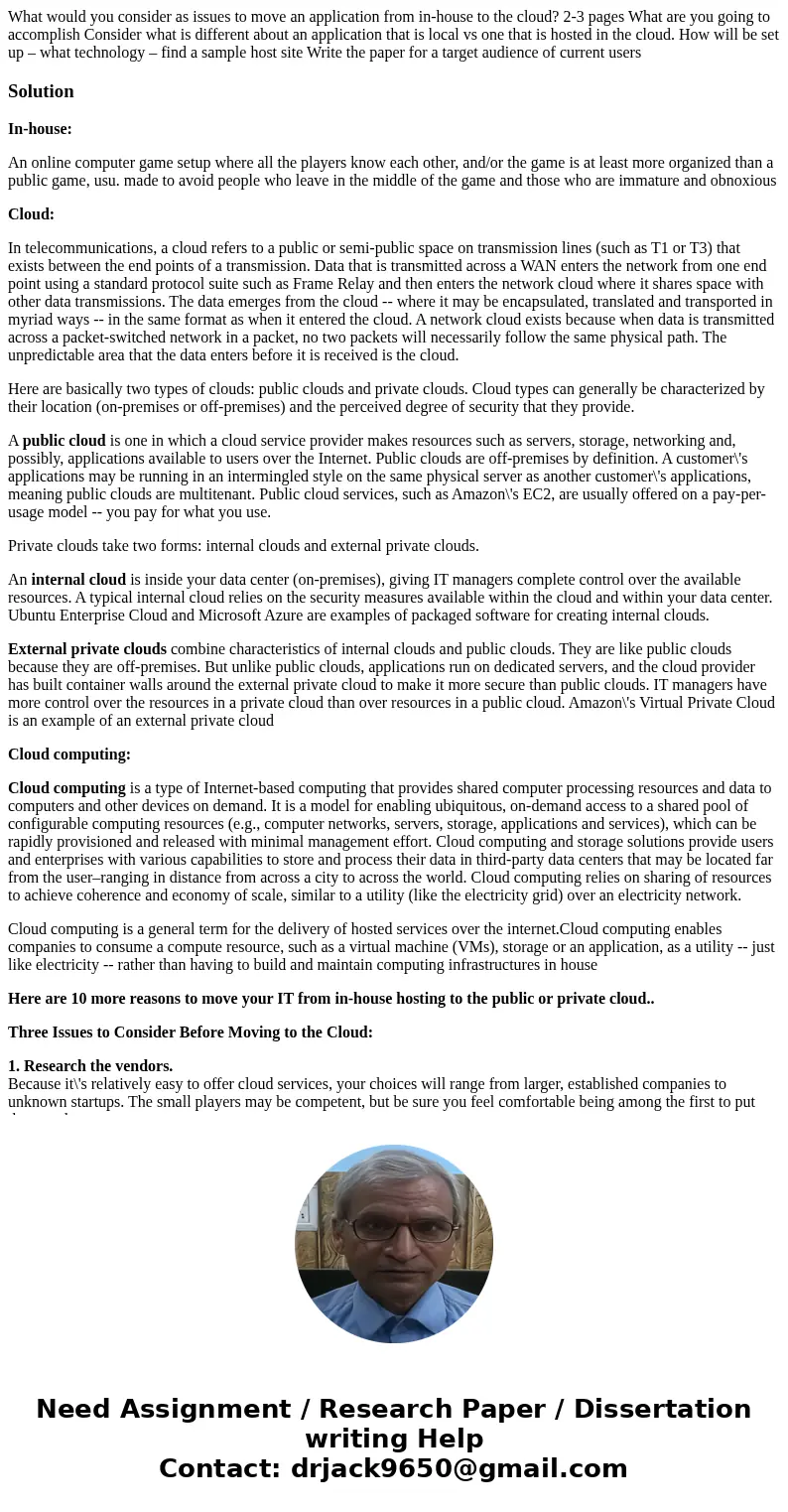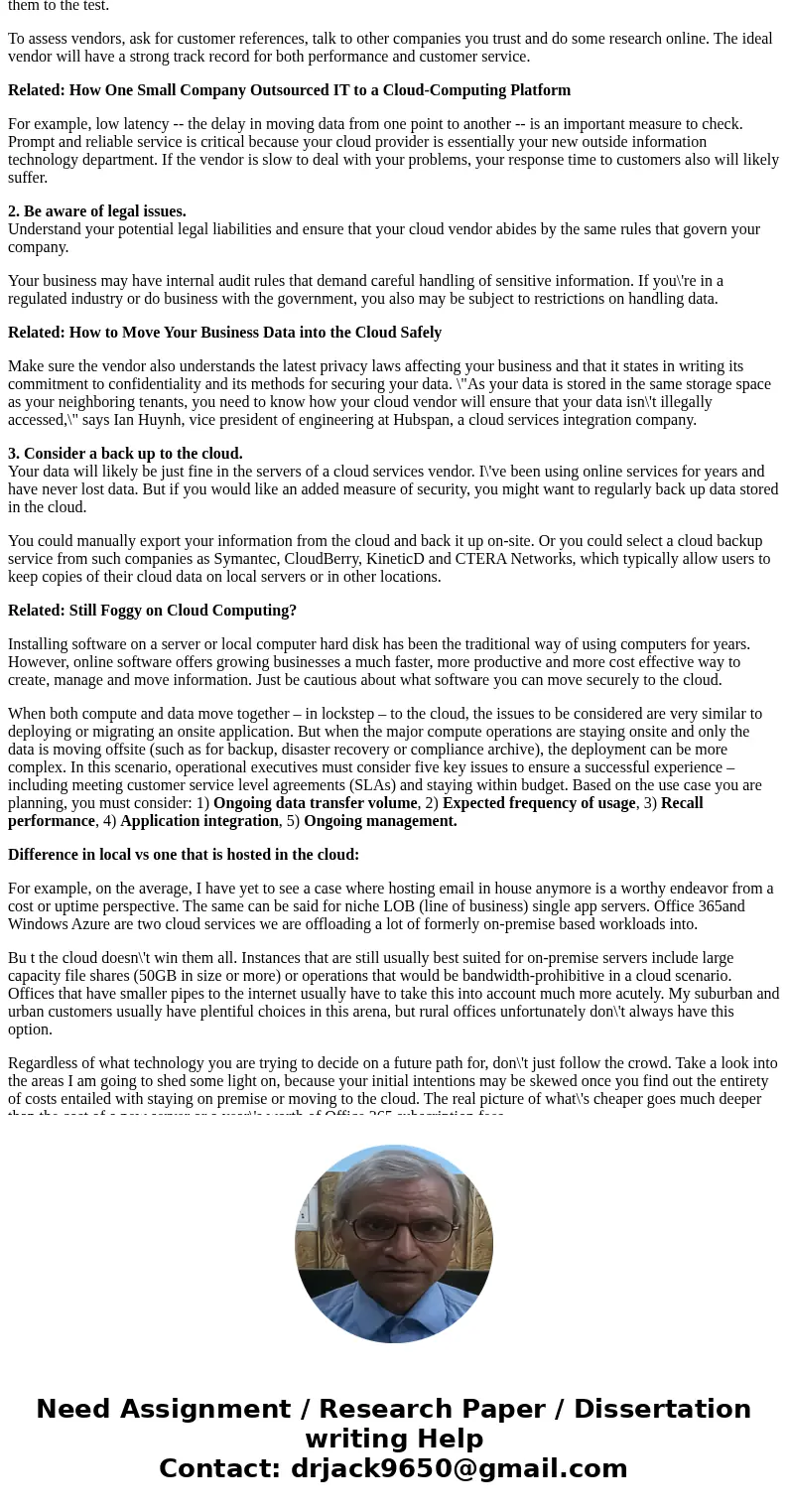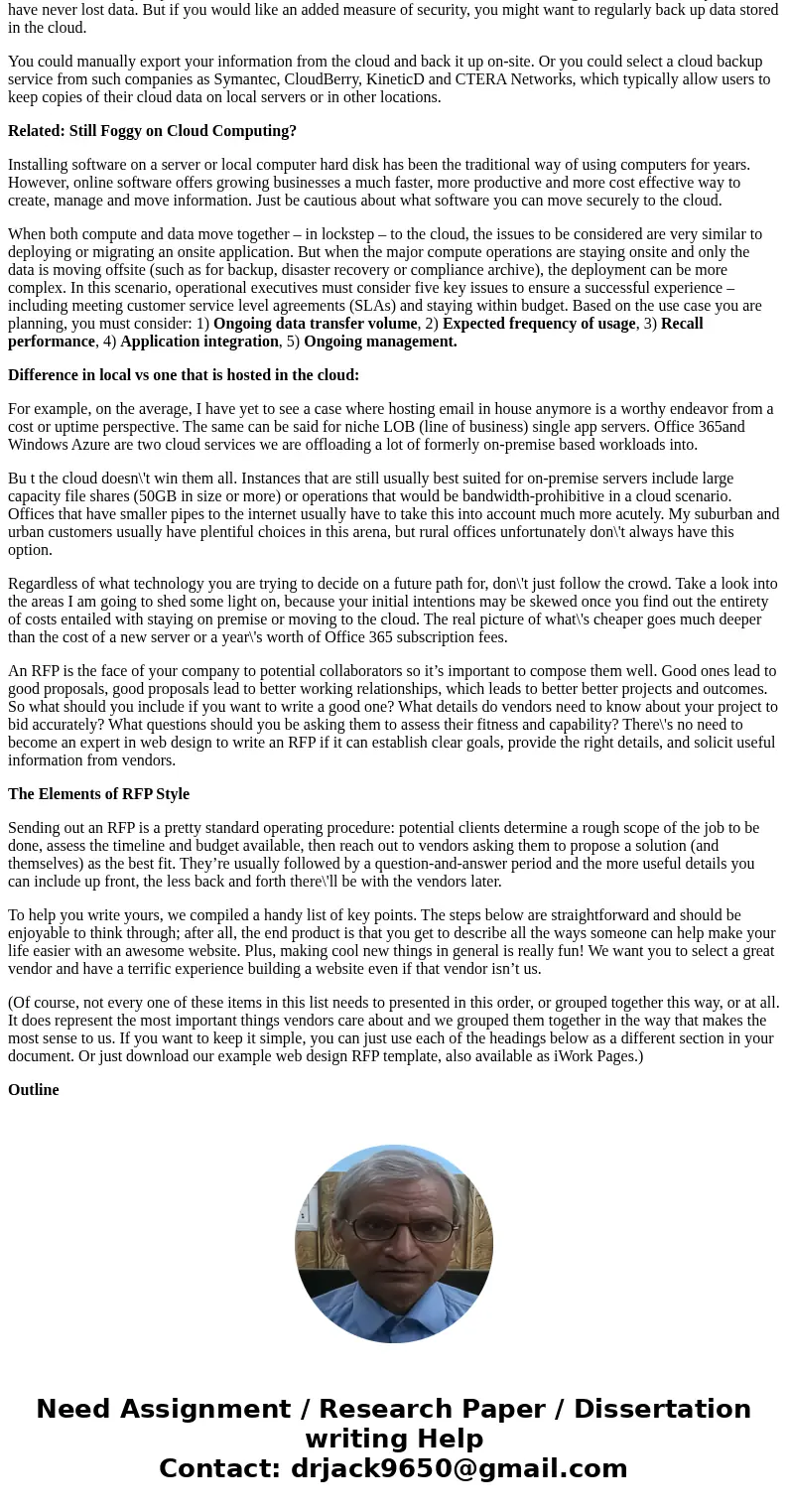What would you consider as issues to move an application fro
What would you consider as issues to move an application from in-house to the cloud? 2-3 pages What are you going to accomplish Consider what is different about an application that is local vs one that is hosted in the cloud. How will be set up – what technology – find a sample host site Write the paper for a target audience of current users
Solution
In-house:
An online computer game setup where all the players know each other, and/or the game is at least more organized than a public game, usu. made to avoid people who leave in the middle of the game and those who are immature and obnoxious
Cloud:
In telecommunications, a cloud refers to a public or semi-public space on transmission lines (such as T1 or T3) that exists between the end points of a transmission. Data that is transmitted across a WAN enters the network from one end point using a standard protocol suite such as Frame Relay and then enters the network cloud where it shares space with other data transmissions. The data emerges from the cloud -- where it may be encapsulated, translated and transported in myriad ways -- in the same format as when it entered the cloud. A network cloud exists because when data is transmitted across a packet-switched network in a packet, no two packets will necessarily follow the same physical path. The unpredictable area that the data enters before it is received is the cloud.
Here are basically two types of clouds: public clouds and private clouds. Cloud types can generally be characterized by their location (on-premises or off-premises) and the perceived degree of security that they provide.
A public cloud is one in which a cloud service provider makes resources such as servers, storage, networking and, possibly, applications available to users over the Internet. Public clouds are off-premises by definition. A customer\'s applications may be running in an intermingled style on the same physical server as another customer\'s applications, meaning public clouds are multitenant. Public cloud services, such as Amazon\'s EC2, are usually offered on a pay-per-usage model -- you pay for what you use.
Private clouds take two forms: internal clouds and external private clouds.
An internal cloud is inside your data center (on-premises), giving IT managers complete control over the available resources. A typical internal cloud relies on the security measures available within the cloud and within your data center. Ubuntu Enterprise Cloud and Microsoft Azure are examples of packaged software for creating internal clouds.
External private clouds combine characteristics of internal clouds and public clouds. They are like public clouds because they are off-premises. But unlike public clouds, applications run on dedicated servers, and the cloud provider has built container walls around the external private cloud to make it more secure than public clouds. IT managers have more control over the resources in a private cloud than over resources in a public cloud. Amazon\'s Virtual Private Cloud is an example of an external private cloud
Cloud computing:
Cloud computing is a type of Internet-based computing that provides shared computer processing resources and data to computers and other devices on demand. It is a model for enabling ubiquitous, on-demand access to a shared pool of configurable computing resources (e.g., computer networks, servers, storage, applications and services), which can be rapidly provisioned and released with minimal management effort. Cloud computing and storage solutions provide users and enterprises with various capabilities to store and process their data in third-party data centers that may be located far from the user–ranging in distance from across a city to across the world. Cloud computing relies on sharing of resources to achieve coherence and economy of scale, similar to a utility (like the electricity grid) over an electricity network.
Cloud computing is a general term for the delivery of hosted services over the internet.Cloud computing enables companies to consume a compute resource, such as a virtual machine (VMs), storage or an application, as a utility -- just like electricity -- rather than having to build and maintain computing infrastructures in house
Here are 10 more reasons to move your IT from in-house hosting to the public or private cloud..
Three Issues to Consider Before Moving to the Cloud:
1. Research the vendors.
Because it\'s relatively easy to offer cloud services, your choices will range from larger, established companies to unknown startups. The small players may be competent, but be sure you feel comfortable being among the first to put them to the test.
To assess vendors, ask for customer references, talk to other companies you trust and do some research online. The ideal vendor will have a strong track record for both performance and customer service.
Related: How One Small Company Outsourced IT to a Cloud-Computing Platform
For example, low latency -- the delay in moving data from one point to another -- is an important measure to check. Prompt and reliable service is critical because your cloud provider is essentially your new outside information technology department. If the vendor is slow to deal with your problems, your response time to customers also will likely suffer.
2. Be aware of legal issues.
Understand your potential legal liabilities and ensure that your cloud vendor abides by the same rules that govern your company.
Your business may have internal audit rules that demand careful handling of sensitive information. If you\'re in a regulated industry or do business with the government, you also may be subject to restrictions on handling data.
Related: How to Move Your Business Data into the Cloud Safely
Make sure the vendor also understands the latest privacy laws affecting your business and that it states in writing its commitment to confidentiality and its methods for securing your data. \"As your data is stored in the same storage space as your neighboring tenants, you need to know how your cloud vendor will ensure that your data isn\'t illegally accessed,\" says Ian Huynh, vice president of engineering at Hubspan, a cloud services integration company.
3. Consider a back up to the cloud.
Your data will likely be just fine in the servers of a cloud services vendor. I\'ve been using online services for years and have never lost data. But if you would like an added measure of security, you might want to regularly back up data stored in the cloud.
You could manually export your information from the cloud and back it up on-site. Or you could select a cloud backup service from such companies as Symantec, CloudBerry, KineticD and CTERA Networks, which typically allow users to keep copies of their cloud data on local servers or in other locations.
Related: Still Foggy on Cloud Computing?
Installing software on a server or local computer hard disk has been the traditional way of using computers for years. However, online software offers growing businesses a much faster, more productive and more cost effective way to create, manage and move information. Just be cautious about what software you can move securely to the cloud.
When both compute and data move together – in lockstep – to the cloud, the issues to be considered are very similar to deploying or migrating an onsite application. But when the major compute operations are staying onsite and only the data is moving offsite (such as for backup, disaster recovery or compliance archive), the deployment can be more complex. In this scenario, operational executives must consider five key issues to ensure a successful experience – including meeting customer service level agreements (SLAs) and staying within budget. Based on the use case you are planning, you must consider: 1) Ongoing data transfer volume, 2) Expected frequency of usage, 3) Recall performance, 4) Application integration, 5) Ongoing management.
Difference in local vs one that is hosted in the cloud:
For example, on the average, I have yet to see a case where hosting email in house anymore is a worthy endeavor from a cost or uptime perspective. The same can be said for niche LOB (line of business) single app servers. Office 365and Windows Azure are two cloud services we are offloading a lot of formerly on-premise based workloads into.
Bu t the cloud doesn\'t win them all. Instances that are still usually best suited for on-premise servers include large capacity file shares (50GB in size or more) or operations that would be bandwidth-prohibitive in a cloud scenario. Offices that have smaller pipes to the internet usually have to take this into account much more acutely. My suburban and urban customers usually have plentiful choices in this arena, but rural offices unfortunately don\'t always have this option.
Regardless of what technology you are trying to decide on a future path for, don\'t just follow the crowd. Take a look into the areas I am going to shed some light on, because your initial intentions may be skewed once you find out the entirety of costs entailed with staying on premise or moving to the cloud. The real picture of what\'s cheaper goes much deeper than the cost of a new server or a year\'s worth of Office 365 subscription fees.
An RFP is the face of your company to potential collaborators so it’s important to compose them well. Good ones lead to good proposals, good proposals lead to better working relationships, which leads to better better projects and outcomes. So what should you include if you want to write a good one? What details do vendors need to know about your project to bid accurately? What questions should you be asking them to assess their fitness and capability? There\'s no need to become an expert in web design to write an RFP if it can establish clear goals, provide the right details, and solicit useful information from vendors.
The Elements of RFP Style
Sending out an RFP is a pretty standard operating procedure: potential clients determine a rough scope of the job to be done, assess the timeline and budget available, then reach out to vendors asking them to propose a solution (and themselves) as the best fit. They’re usually followed by a question-and-answer period and the more useful details you can include up front, the less back and forth there\'ll be with the vendors later.
To help you write yours, we compiled a handy list of key points. The steps below are straightforward and should be enjoyable to think through; after all, the end product is that you get to describe all the ways someone can help make your life easier with an awesome website. Plus, making cool new things in general is really fun! We want you to select a great vendor and have a terrific experience building a website even if that vendor isn’t us.
(Of course, not every one of these items in this list needs to presented in this order, or grouped together this way, or at all. It does represent the most important things vendors care about and we grouped them together in the way that makes the most sense to us. If you want to keep it simple, you can just use each of the headings below as a different section in your document. Or just download our example web design RFP template, also available as iWork Pages.)
Outline



 Homework Sourse
Homework Sourse